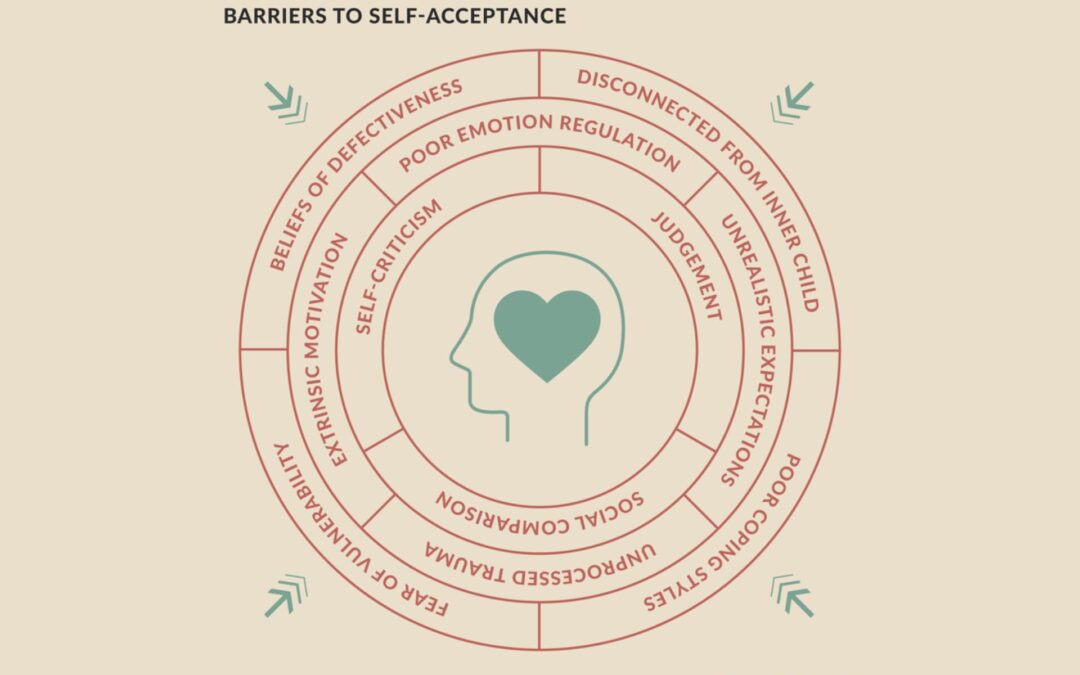Since I’ve been in the therapy world, one of the most common things I hear from clients is some version of, “How do I accept ___?” Often, this question is framed with some aspect of self-acceptance, or some aspect of themselves that my clients ae struggling to be “okay” with. Other times, it is more of a goal, framed as, “I want to be able to accept my ____.” When this comes up, I eventually introduce them to a theory called Acceptance and Commitment Therapy, or ACT for short. Or even more specifically, to an ACT principle called the Barriers to Self-Acceptance.
The ACBS defines ACT as, “A unique empirically based psychological intervention that uses acceptance and mindfulness strategies, together with commitment and behavior change strategies, to increase psychological flexibility.” If you’re like me, you’re probably looking for the simple definition. Simply put, ACT uses acceptance of self and others, mindfulness, and commitment to change in order to create a desired change.
When looking at self-acceptance through an ACT lens, we often impose some form of self-inflicted barrier that can hold us back from accepting our thoughts, beliefs, emotions, actions, words, and interactions with others, or even some aspect of our personality we want to change. I often use this diagram with clients, going over each aspect, identifying barriers, and then implementing mindfulness, acceptance, and change plans for any selected barrier.
The Barriers of Self-Acceptance (ACT) include:
- Beliefs of Defectiveness
- Fear of Vulnerability
- Poor Coping Styles
- Disconnection from Inner Child
- Poor Emotional Regulation
- Unrealistic Expectations
- Unprocessed Trauma
- Extrinsic Motivation
- Self-Criticism
- Judgement
- Social Comparison
So, what do these barriers mean? And what do I do about them?
Here’s a simpler breakdown of the barriers:
- Beliefs of Defectiveness: It can be said that our self-talk boils down to our way of navigating ourselves through the world. Our internal speech affects the way we look at ourselves, our beliefs, and even how we interact with others. If we believe we are defective, or talk negatively to ourselves, over time, this becomes our lens of seeing the world.
- Fear of Vulnerability: The fear of being open and vulnerable with ourselves, or others, can keep us from accepting ourselves and others. Allowing yourself to open up to others, even if it’s a therapist, can create an additional outlet for processing.
- Poor Coping Styles: Often called maladaptive coping, these are things we do to cope that don’t benefit us. They can include: excessive eating, addictions to drugs, sex, gambling, and alcohol, excessive time on social media or playing video games, self-harm, over-exercising, isolating from others. Looking at creating a positive coping skills plan can help.
- Disconnection from Inner Child: We each have an inner child, a part of us that is less touched by the world. Our level of closeness and connection to what this child wants/needs/is saying can often affect our levels of self-acceptance.
- Poor Emotional Regulation: The way we accept and process our emotions often can lead to how we view and talk about ourselves and others. Taking an emotional inventory, doing emotions-focused therapy, or looking at emotions solely as information can change the level of effect our emotions have on us.
- Unrealistic Expectations: The level of expectations we put on ourselves and others can either give us grace or set us up for failure. Examining your expectations about a person, situation, or even yourself can help to tell you your acceptance level.
- Unprocessed Trauma: Unprocessed trauma can leave us with physical, mental, emotional, and relational symptoms. Processing trauma with a licensed therapist either through EMDR, brain spotting, or talk therapy can unlock certain aspects of ourselves that we have shut out.
- Extrinsic Motivation: If our goals for self-acceptance are extrinsic, or something outside of us, we go into self-acceptance with the wrong reasons and mindsets. Similarly to our expectations, examining our motivations towards ourselves and others can reset our self-acceptance journey.
- Self-Criticism and Judgement: Similar to self-talk, the way we criticize ourselves, and the lenses of judgement we look through affect how we process and act upon a situation. Knowing your go-to judgements ad criticisms, and examining their effectiveness or truth is a strong first step.
- Social Comparison: Comparing ourselves to others, famous, family, or friends, can create unrealistic expectations that make it more difficult to accept ourselves. You can begin looking at this by asking yourself who you look up to, if there is anyone you look down on, and who you compare yourself to most.
If you’ve identified these barriers in yourself, or are struggling to find your barrier, you may be curious as to what they mean, or what you can do about/with them. While this blog post can give you a good start, it’s recommended to work through these barriers in detail in therapy, with an unbiased source.

